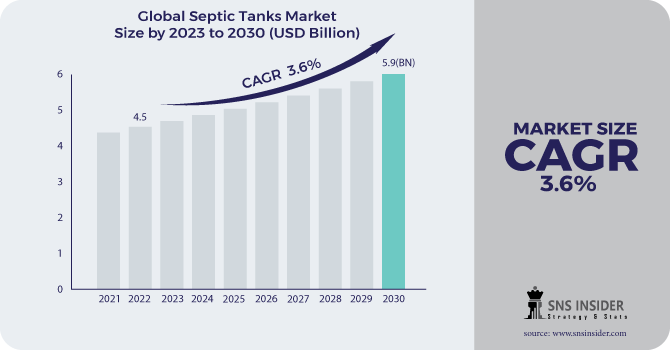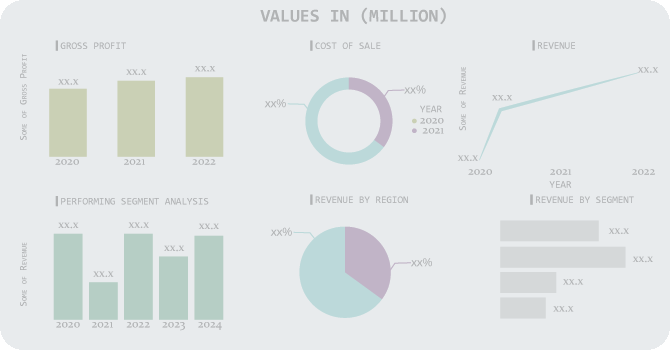Septic Tanks Market Scope & Overview:
The Septic Tanks Market size was valued at USD 4.8 billion in 2023 and is expected to grow to USD 6.35 billion by 2031 and grow at a CAGR of 3.45 % over the forecast period of 2024-2031.
Septic tanks are an essential component of a home's wastewater management system. They are designed to collect and treat sewage and other waste materials from the household. The septic tank is typically buried underground and consists of two chambers. The first chamber receives the wastewater from the house, where solids settle to the bottom and are broken down by bacteria. The liquid then flows into the second chamber, where further treatment occurs before it is released into the drain field. Proper maintenance of a septic tank is crucial to ensure its longevity and effectiveness. Regular pumping and inspection are necessary to prevent blockages and backups. It is also important to avoid flushing non-biodegradable materials, such as wipes and feminine hygiene products, down the toilet, as they can clog the system. In addition to being a vital part of a home's wastewater management system, septic tanks can also have an impact on the environment. If not properly maintained, they can leak harmful pollutants into the soil and groundwater.

To get more information on Septic Tanks Market - Request Free Sample Report
The septic tank market is influenced by a variety of factors that contribute to its growth and development. These factors include advancements in technology, increasing demand for sustainable and eco-friendly solutions, and government regulations. Technological advancements have led to the development of more efficient and effective septic tank systems. These systems are designed to reduce waste and improve overall performance, making them more attractive to consumers. Additionally, Government regulations also play a significant role in the septic tank market. Regulations regarding the disposal of waste and the use of septic tanks have become increasingly strict, which has led to a greater demand for high-quality septic tank systems that meet these regulations.
Market Dynamics
Drivers
-
Increasing adoption of septic tanks in the rural area
-
Rapidly growing population and urbanization
-
Increasing residential and commercial construction
-
Increasing awareness regarding effective solutions for waste management
-
Increasing need for eco-friendly solutions to the waste management
The growing demand for environmentally-friendly waste management solutions is the primary driving force behind the Septic Tanks Market. As society becomes more conscious of the impact of waste on the environment, there is a greater need for sustainable and efficient methods of waste disposal. Septic tanks offer a practical and cost-effective solution for managing household and commercial waste, making them a popular choice for many consumers. As a result, the Septic Tanks Market is expected to continue to grow in the coming years, driven by the increasing demand for eco-friendly waste management solutions.
Restrain
-
High cost associated with the concrete septic tanks
Opportunities
-
Rise in the investment by the government in infrastructure projects
-
Technological advancements in the septic systems
The septic tank market has the potential to benefit greatly from technological advancements in septic systems. As new technologies emerge, septic systems are becoming more efficient, cost-effective, and environmentally friendly. These advancements include the use of advanced filtration systems, smart monitoring systems, and innovative materials that improve the durability and longevity of septic tanks. Investing in these new technologies can help septic tank manufacturers and service providers stay ahead of the competition and meet the growing demand for sustainable and efficient wastewater management solutions. By embracing these advancements, the septic tank market can not only improve the quality of its products and services but also contribute to a cleaner and healthier environment for all.
Challenges
-
High prices of raw materials required for the septic systems
Impact of COVID-19
The outbreak of coronavirus impacted the septic tank market significantly. The pandemic has caused a disruption in the supply chain of septic tanks, leading to a shortage of materials and labor. This has resulted in a delay in the production and delivery of septic tanks, causing a backlog in orders and a decrease in revenue for companies in the industry. Furthermore, the pandemic has also affected the demand for septic tanks. With the economic downturn caused by the pandemic, many homeowners and businesses have had to cut back on expenses, including the installation and maintenance of septic tanks. This has led to a decrease in demand for septic tanks.
Impact of Russia-Ukraine War
The ongoing conflict between Russia and Ukraine has had a significant impact on various industries, including the septic tank market. The septic tank market in Ukraine has been particularly affected by the war. The conflict has disrupted the supply chain, making it difficult for manufacturers to obtain raw materials and distribute their products. Additionally, the economic instability caused by the war has led to a decrease in consumer spending, further impacting the demand for septic tanks. On the other hand, the septic tank market in Russia has seen a slight increase in demand. This is due to the government's efforts to improve the country's sanitation infrastructure, which has led to an increase in construction projects and the installation of septic tanks.
Impact of Recession
The economic downturn impacted the septic tank market. As the economy has slowed down, so has the demand for septic tanks. This has led to a decrease in sales and revenue for companies in the septic tank industry. However, the recession has also created opportunities for companies to innovate and improve their products. With fewer customers, companies have had to find ways to make their septic tanks more efficient and cost-effective. This has led to the development of new technologies and materials that have improved the performance of septic tanks.
Key Market Segmentation
By Type
-
Conventional
-
Chambered
-
Drip Distribution
-
Others
By Material
-
Concrete
-
Fiberglass
-
Plastic
-
Others
By Size
-
<1000 liters
-
1000-5000 liters
-
5000-10000 liters
-
>5000 liters
By Application
-
Residential
-
Commercial
-
Industrial
.png)
Need any customization research on Septic Tanks Market - Enquiry Now
Regional Analysis
The Asia-Pacific region has emerged as the dominant player in the septic tanks market in 2023 and is expected to maintain its lead during the forecast period. This can be attributed to the increasing number of septic tanks demand for commercial and residential construction projects. The other factors that propel the septic tank market are population growth, urbanization, and a lack of centralized sewage systems. As the population in the region continues to grow, so does the need for proper sanitation facilities. Many areas in the Asia Pacific region are experiencing rapid urbanization, which has led to an increase in the number of households and businesses that require access to reliable sewage systems. Furthermore, the lack of centralized sewage systems in many areas has made septic tanks a popular choice for those looking to manage their wastewater. Septic tanks are a cost-effective and efficient way to treat and dispose of wastewater, making them an attractive option for many households and businesses.
North America is expected to grow with the highest CAGR during the forecast period owing to government regulations, technological advancements, and the increasing cost of traditional sewer systems.
REGIONAL COVERAGE:
-
North America
-
USA
-
Canada
-
Mexico
-
-
Europe
-
Germany
-
UK
-
France
-
Italy
-
Spain
-
The Netherlands
-
Rest of Europe
-
-
Asia-Pacific
-
Japan
-
south Korea
-
China
-
India
-
Australia
-
Rest of Asia-Pacific
-
-
The Middle East & Africa
-
Israel
-
UAE
-
South Africa
-
Rest of the Middle East & Africa
-
-
Latin America
-
Brazil
-
Argentina
-
Rest of Latin America
-
Key Players
The major key players are Kingspan Group, Saint Dizier Environnement, Advanced Drainage Systems, Biorock, Inc., Conder Sewage Technology Ltd, Chem-Tainer Industries, Eurobeton, Graf UK Ltd, Danmotech Ltd., Orenco Systems, Inc., Techneau, WPL Ltd, Simop, Zehnder Pumpen GmbH, and other key players mentioned in the final report.
Kingspan Group-Company Financial Analysis

| Report Attributes | Details |
| Market Size in 2023 | US$ 4.8 Bn |
| Market Size by 2031 | US$ 6.35 Bn |
| CAGR | CAGR of 3.45% From 2024 to 2031 |
| Base Year | 2022 |
| Forecast Period | 2024-2031 |
| Historical Data | 2020-2021 |
| Report Scope & Coverage | Market Size, Segments Analysis, Competitive Landscape, Regional Analysis, DROC & SWOT Analysis, Forecast Outlook |
| Key Segments | • By Type (Conventional, Chambered, Drip Distribution, and others) • By Material (Concrete, Fiberglass, Plastic, Others) • By Size (<1000>5000 liters) • By Application (Residential, Commercial, and Industrial) |
| Regional Analysis/Coverage | North America (USA, Canada, Mexico), Europe (Germany, UK, France, Italy, Spain, Netherlands, Rest of Europe), Asia-Pacific (Japan, South Korea, China, India, Australia, Rest of Asia-Pacific), The Middle East & Africa (Israel, UAE, South Africa, Rest of Middle East & Africa), Latin America (Brazil, Argentina, Rest of Latin America) |
| Company Profiles | Kingspan Group, Saint Dizier Environnement, Advanced Drainage Systems, Biorock, Inc., Conder Sewage Technology Ltd, Chem-Tainer Industries, Eurobeton, Graf UK Ltd, Danmotech Ltd., Orenco Systems, Inc., Techneau, WPL Ltd, Simop, Zehnder Pumpen GmbH, and other |
| Key Drivers | • Increasing adoption of septic tanks in the rural area • Rapidly growing population and urbanization • Increasing residential and commercial construction |
| Market Opportunities | • Rise in the investment by the government in infrastructure projects • Technological advancements in the septic systems |

